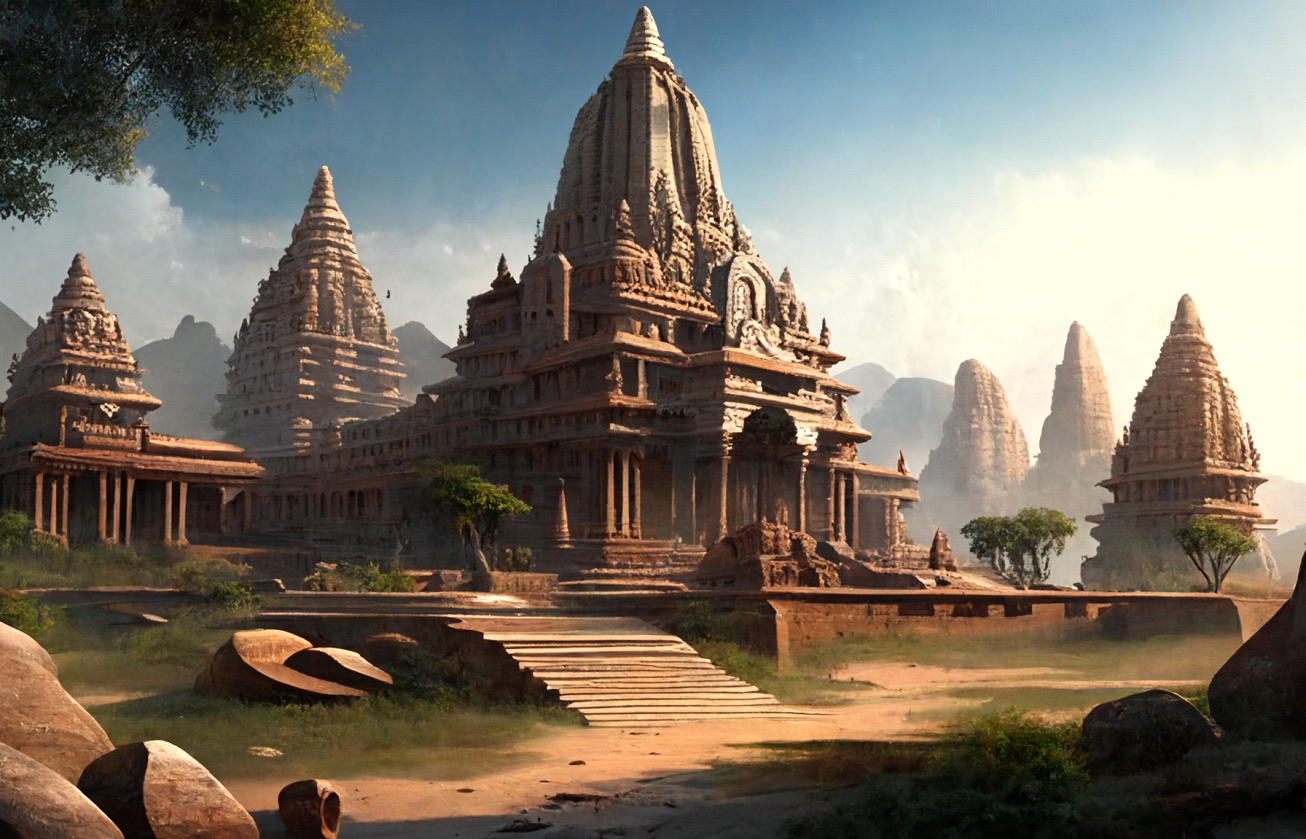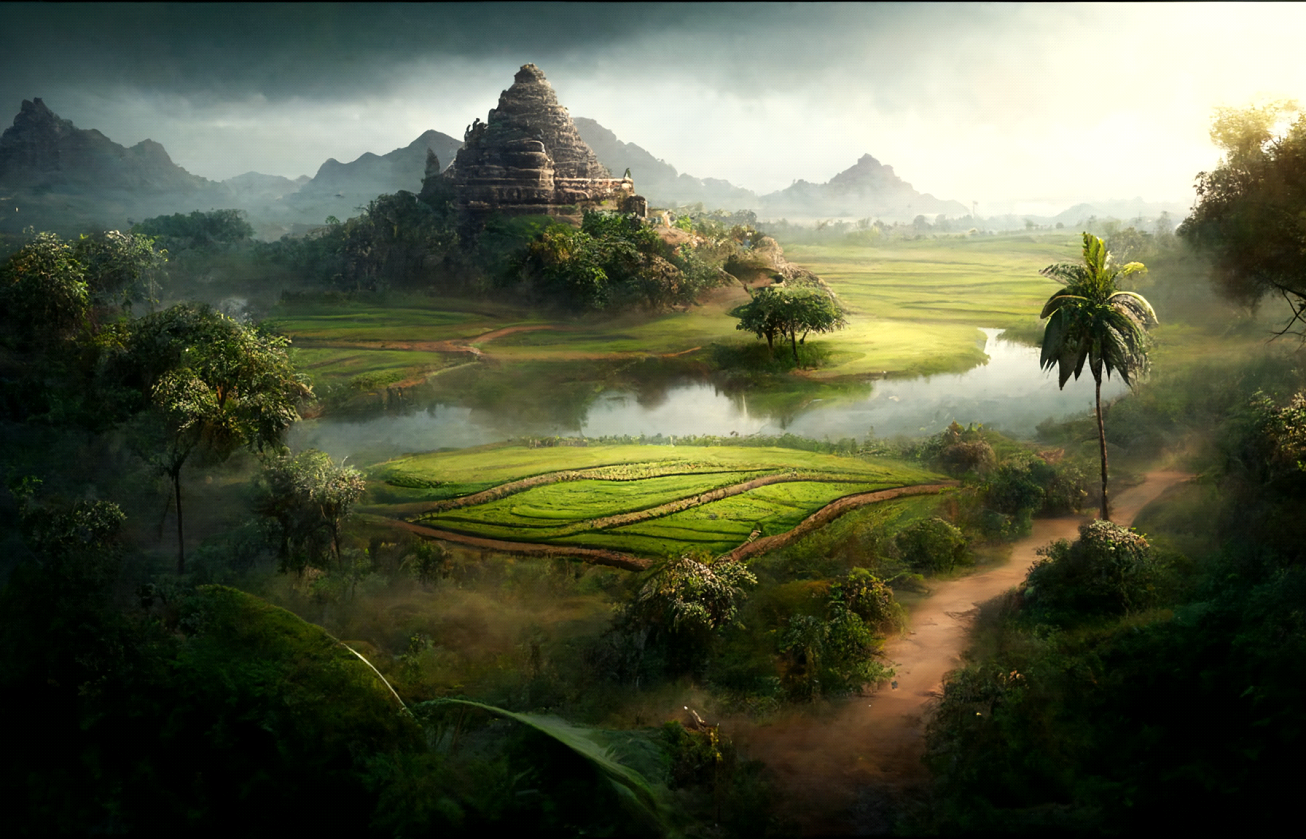Merrapi
Pronunciation: mer-RAPPY
Map Index: G11, G12
Location: Southeast Nhulokkarnum
Description: The human kingdom of Merrapi is situated at the southeasternmost point of Nhulokkarnum, an area deeply impacted by the catastrophic events of the Great Cataclysm. The area has a tropical climate with distinct wet and dry seasons. The land is heavily cultivated but plenty of forests still exist. Parts of the land near the Nhulokkarnum Mountains in the west are wild and beyond the control of the kingdom.
Residents: The inhabitants of Merrapi, humans of mixed Chuuli and Mu descent, make up the vast majority of the population. Small numbers of Valmyrri live in port cities. The society as a whole retains limited knowledge and understanding of their nation's history and events that precede the Great Cataclysm are treated as myths.
The use of arcane magic is rare today, as most mages that were well versed in it did not survive the ravages of the cataclysm. Today only a few small, isolated institutions possess the remnants of a once expansive knowledge of arcane practices. Divine magic, however, is still vibrant and in widespread use. Priests of the old religions still practice much as they did in the pre-cataclysm age, just in smaller and more simple buildings than the enormous, magnificent temples of long ago.
Small populations of Catfolk live in the western part of the sultanate along the fringes of civilization. Formerly human, the chaos storms of the Great Cataclysm corrupted them and transformed them into cat-like humanoids. They are accepted as members of the sultanate but often get treated as second class citizens.
The western half of Merrapi, particularly near the Nhulokk Range, finds populations of Tengu, a crow-like humanoid. A great many migrated into urban areas where they form a minority of the population.
Skinwalkers, another humanoid produced by the chaos storms, possess the ability to transform into bestial humanoids. This greatly feared race lives within Merrapi, posing as humans, all the while carefully guarding their secret. They live their lives in constant fear of discovery as Skinwalkers face extreme hostility and often face exile or execution by fire when discovered. In the heavily forested areas, small tribes of Vanara live in the trees. These monkey-like humanoids rarely leave the forests and prefer to keep to themselves in treetop enclaves.
Primary Population: Chuuli
Secondary Population: Mu
Minor Population: Ansharri, Valmyrri
Government and Politics: Merrapi, ruled by a weak and ineffective sultan who lacks any real power, suffers from debilitating disfunction and disorganization. The sultan, the nominal leader of the kingdom, effectively serves as little more than a ceremonial figurehead. With the sultan isolated inside an elaborately decorated palace, cities and towns, left to fend for themselves, spend much of their energy locked in conflicts. This results in large parts of the country stuck in a perpetual state of crisis.
Economy: The kingdom's predominantly agrarian economy, depends almost entirely upon cultivating and exporting large amouts of exotic fruits. This enriches large wealthy landowners but leads to a large portion of the rural population living at bare subsistence levels.
Military: No cohesive national defence force exists. The Sultan controls only a small command of palace guards. While these soldiers are elite, they are too few in number to exert any real influence outside of the capital. This leaves the real power in the hands of the wealthy aristocracy who control local militias or bankroll private armies that operate independent of any central control. This results in tremendous instability and internal hostilities, which leads to open warfare breaking out. All of this renders Merrapi vulnerable to attacks by tribes of marauding humanoids and abberations dwelling in the Sau'tok Mountains. Lacking sufficient funds, the government troops raised by most cities are comprised of poorly trained and led foot soldiers.
History: The landscape is dotted with shattered remnants of once-majestic buildings, temples, and structures, which remain mostly abandoned. When the Great Cataclysm struck, the kingdom's coastline suddenly sank, leaving many of the kingdom's great cities and ports submerged. Furthermore, relentless severe earthquakes reduced many once grand cities to rubble. The catastrophic events that transpired also resulted in a great loss of knowledge, leaving the population with only fragments of their storied past.
Today: The descendants of the survivors of the Great Cataclysm still cling to hopes of reclaiming the former glory of their realm. Despite the challenges and hardships faced by the people of Merrapi, a glimmer of hope remains as they strive to rebuild and rediscover their past. With remnants of the past scattered across the land and a determination to overcome adversity, the kingdom of Merrapi stands a chance to reclaim their heritage due to the resilience and indomitable spirit of its people.
Map Index: G11, G12
Location: Southeast Nhulokkarnum
Description: The human kingdom of Merrapi is situated at the southeasternmost point of Nhulokkarnum, an area deeply impacted by the catastrophic events of the Great Cataclysm. The area has a tropical climate with distinct wet and dry seasons. The land is heavily cultivated but plenty of forests still exist. Parts of the land near the Nhulokkarnum Mountains in the west are wild and beyond the control of the kingdom.
Residents: The inhabitants of Merrapi, humans of mixed Chuuli and Mu descent, make up the vast majority of the population. Small numbers of Valmyrri live in port cities. The society as a whole retains limited knowledge and understanding of their nation's history and events that precede the Great Cataclysm are treated as myths.
The use of arcane magic is rare today, as most mages that were well versed in it did not survive the ravages of the cataclysm. Today only a few small, isolated institutions possess the remnants of a once expansive knowledge of arcane practices. Divine magic, however, is still vibrant and in widespread use. Priests of the old religions still practice much as they did in the pre-cataclysm age, just in smaller and more simple buildings than the enormous, magnificent temples of long ago.
Small populations of Catfolk live in the western part of the sultanate along the fringes of civilization. Formerly human, the chaos storms of the Great Cataclysm corrupted them and transformed them into cat-like humanoids. They are accepted as members of the sultanate but often get treated as second class citizens.
The western half of Merrapi, particularly near the Nhulokk Range, finds populations of Tengu, a crow-like humanoid. A great many migrated into urban areas where they form a minority of the population.
Skinwalkers, another humanoid produced by the chaos storms, possess the ability to transform into bestial humanoids. This greatly feared race lives within Merrapi, posing as humans, all the while carefully guarding their secret. They live their lives in constant fear of discovery as Skinwalkers face extreme hostility and often face exile or execution by fire when discovered. In the heavily forested areas, small tribes of Vanara live in the trees. These monkey-like humanoids rarely leave the forests and prefer to keep to themselves in treetop enclaves.
Primary Population: Chuuli
Secondary Population: Mu
Minor Population: Ansharri, Valmyrri
Government and Politics: Merrapi, ruled by a weak and ineffective sultan who lacks any real power, suffers from debilitating disfunction and disorganization. The sultan, the nominal leader of the kingdom, effectively serves as little more than a ceremonial figurehead. With the sultan isolated inside an elaborately decorated palace, cities and towns, left to fend for themselves, spend much of their energy locked in conflicts. This results in large parts of the country stuck in a perpetual state of crisis.
Economy: The kingdom's predominantly agrarian economy, depends almost entirely upon cultivating and exporting large amouts of exotic fruits. This enriches large wealthy landowners but leads to a large portion of the rural population living at bare subsistence levels.
Military: No cohesive national defence force exists. The Sultan controls only a small command of palace guards. While these soldiers are elite, they are too few in number to exert any real influence outside of the capital. This leaves the real power in the hands of the wealthy aristocracy who control local militias or bankroll private armies that operate independent of any central control. This results in tremendous instability and internal hostilities, which leads to open warfare breaking out. All of this renders Merrapi vulnerable to attacks by tribes of marauding humanoids and abberations dwelling in the Sau'tok Mountains. Lacking sufficient funds, the government troops raised by most cities are comprised of poorly trained and led foot soldiers.
History: The landscape is dotted with shattered remnants of once-majestic buildings, temples, and structures, which remain mostly abandoned. When the Great Cataclysm struck, the kingdom's coastline suddenly sank, leaving many of the kingdom's great cities and ports submerged. Furthermore, relentless severe earthquakes reduced many once grand cities to rubble. The catastrophic events that transpired also resulted in a great loss of knowledge, leaving the population with only fragments of their storied past.
Today: The descendants of the survivors of the Great Cataclysm still cling to hopes of reclaiming the former glory of their realm. Despite the challenges and hardships faced by the people of Merrapi, a glimmer of hope remains as they strive to rebuild and rediscover their past. With remnants of the past scattered across the land and a determination to overcome adversity, the kingdom of Merrapi stands a chance to reclaim their heritage due to the resilience and indomitable spirit of its people.

